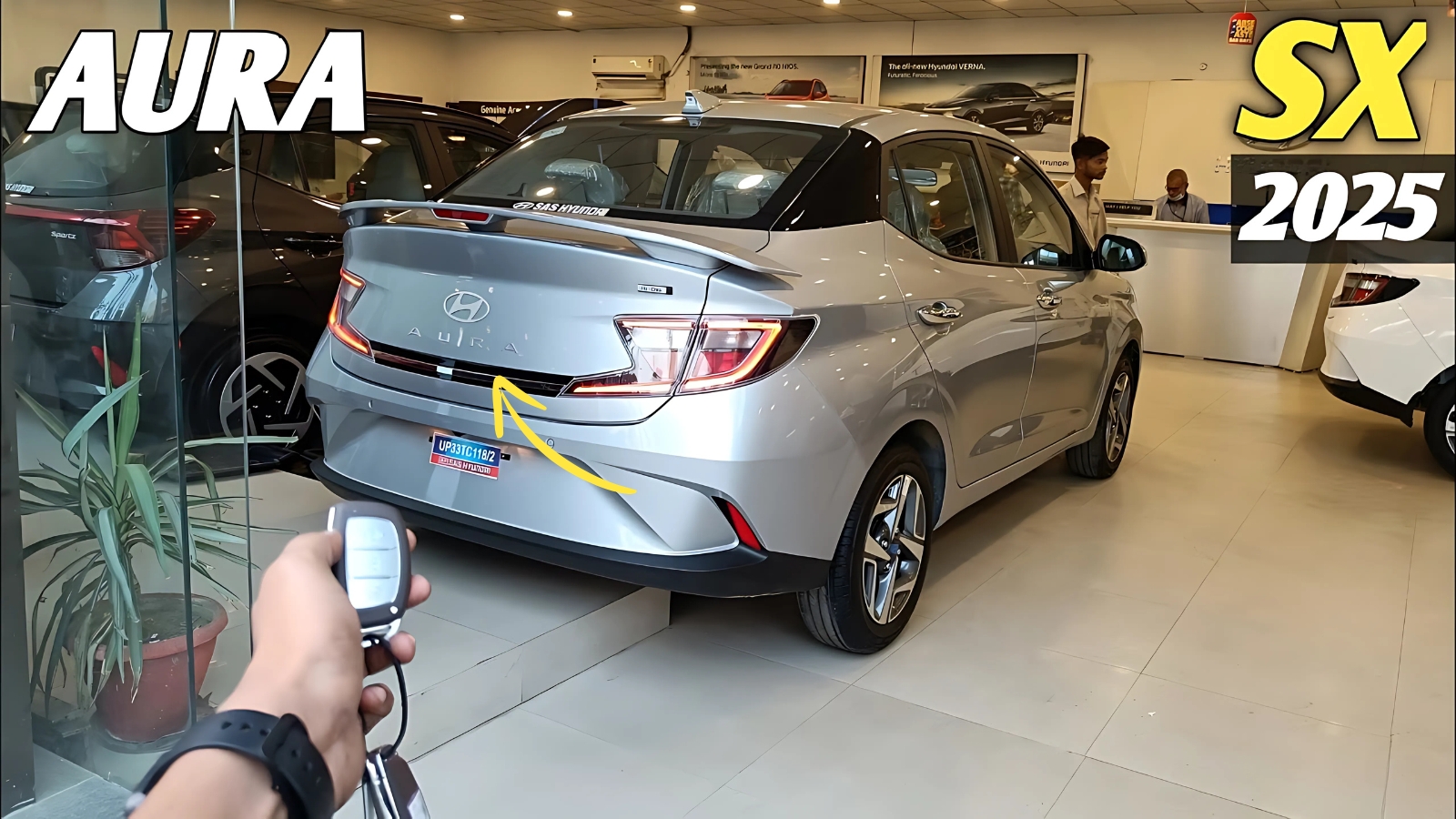Hyundai Aura: The Hyundai Aura continues to establish itself as a formidable competitor in India’s compact sedan segment, with monthly sales figures consistently crossing 5,000 units throughout 2025. Priced between Rs 6.54 lakh and Rs 9.11 lakh ex-showroom, the Aura demonstrates Hyundai’s commitment to delivering premium features at accessible price points, positioning itself as a compelling alternative to segment leader Maruti Suzuki Dzire.
Recent sales data reveals the Aura’s steady performance trajectory, with May 2025 recording 5,225 units sold, representing a robust 24% month-on-month growth. This upward momentum continued into June 2025, where sales reached 5,413 units, marking a 26% year-on-year increase and reinforcing the model’s growing acceptance among Indian consumers seeking value-oriented sedan options.
The introduction of the Corporate variant in February 2025, priced at Rs 7.48 lakh, strategically fills the gap between S and SX variants while targeting fleet buyers and corporate customers. This variant expansion demonstrates Hyundai’s tactical approach to maximizing market coverage and addressing diverse customer requirements within the competitive sub-4-meter sedan category.
Feature-Forward Approach Distinguishes Market Positioning
The Aura’s comprehensive feature list represents a significant competitive advantage in the price-conscious compact sedan segment. The centerpiece 8-inch touchscreen infotainment system surpasses rival offerings in both size and functionality, supporting wired Android Auto and Apple CarPlay connectivity alongside Bluetooth integration and steering-mounted controls for enhanced user convenience.
Safety credentials receive particular emphasis with six airbags standard across all variants, complemented by Electronic Stability Control (ESC), Vehicle Stability Management (VSM), ABS with EBD, and rear parking sensors. This comprehensive safety suite positions the Aura favorably against competitors that often reserve advanced safety features for higher-specification variants.
Comfort and convenience features include automatic climate control, wireless phone charging, rear AC vents, cruise control, push-button start-stop, and a cooled glove compartment. The inclusion of LED DRLs, projector headlamps, and 15-inch diamond-cut alloy wheels on higher variants adds visual appeal while maintaining functional benefits.
However, the feature set reveals some limitations when compared to evolving segment expectations. The absence of wireless Android Auto/Apple CarPlay connectivity creates an inconsistency with the wireless charging provision, while the lack of advanced driver assistance systems (ADAS) becomes increasingly noticeable as competitors introduce such technologies.

Single Engine Strategy Simplifies But Limits Choice
The 2025 Aura utilizes a singular powertrain approach centered on a 1.2-liter naturally aspirated petrol engine producing 83 PS and 114 Nm of torque. This engine pairs with either a 5-speed manual transmission or 5-speed AMT, while CNG variants remain exclusively manual, creating a streamlined but somewhat limited powertrain portfolio compared to the previous generation’s multi-engine approach.
The decision to discontinue the 1.0-liter turbo-petrol and diesel engine options reflects Hyundai’s strategy to simplify manufacturing and reduce complexity while focusing on the most popular powertrain configurations. Real-world performance demonstrates adequate urban capabilities with 0-60 kmph acceleration achieved in 5.33 seconds, though highway overtaking requires planned execution due to the naturally aspirated engine’s characteristics.
Fuel efficiency figures of approximately 20 kmpl for petrol variants and 28 km/kg for CNG configurations provide competitive running costs, particularly important in the price-sensitive compact sedan segment where operational expenses significantly influence purchase decisions.
Design Evolution Addresses Previous Criticisms
The 2023 facelift introduced subtle but meaningful aesthetic improvements, including a slimmer grille design, inverted L-shaped LED DRLs, and revised bumper styling that helps differentiate the Aura from its Grand i10 Nios platform sibling. The addition of the ‘Starry Night’ paint option expands color choices to six variants, providing increased personalization options.
Interior refinements include updated fabric seat patterns, improved material quality, and enhanced fit-and-finish standards that create a more premium cabin ambiance. The dashboard layout incorporates circular AC vents, textured surfaces, and chrome accents that contribute to the sedan’s upmarket positioning within the segment.
However, design challenges persist, particularly regarding the overall silhouette proportions that some observers describe as less cohesive compared to competitors like the Maruti Dzire. The rear design elements, while functional, fail to achieve the visual integration that characterizes the most successful compact sedan designs.
Royal Enfield Classic 350 launched with powerful engine – design is classic
Market Dynamics Reveal Segment Opportunities and Challenges
The compact sedan segment experienced mixed performance in 2025, with the Aura benefiting from overall market consolidation as consumers gravitate toward established brands with strong service networks. While the Maruti Dzire maintains segment leadership with significantly higher sales volumes, the Aura’s consistent performance demonstrates viable space for well-positioned alternatives.
Competition intensity continues increasing with entries from established players and periodic updates from existing competitors. The Honda Amaze, Tata Tigor, and Volkswagen Virtus each present distinct value propositions, creating a dynamic competitive environment that rewards manufacturers offering the optimal balance of features, pricing, and brand appeal.
Fleet and corporate sales represent significant opportunity areas for the Aura, particularly given Hyundai’s reputation for reliability and comprehensive service network coverage. The dedicated Corporate variant specifically targets this market segment, which often prioritizes total cost of ownership over individual feature specifications.
Hyundai Aura Future Outlook Supports Continued Competitiveness
The Aura’s market position appears sustainable based on current performance trends and Hyundai’s strategic focus on the model. Consistent monthly sales volumes above 5,000 units indicate healthy demand levels that justify continued investment in product development and market support activities.
Potential enhancement areas include advanced connectivity features, expanded powertrain options, and possible ADAS integration to maintain competitiveness as segment standards evolve. However, the fundamental formula of comprehensive features, competitive pricing, and reliable performance provides a solid foundation for continued success in India’s compact sedan market.
The model’s success reflects broader market trends favoring established manufacturers with strong brand recognition, comprehensive feature offerings, and competitive pricing strategies. As the compact sedan segment continues evolving, the Aura’s position as a feature-rich alternative to market leaders appears well-positioned for sustained competitiveness through 2025 and beyond.
